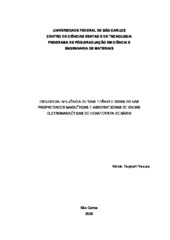| dc.contributor.author | Yasuda, Márcio Tsuyoshi | |
| dc.date.accessioned | 2016-06-02T19:09:59Z | |
| dc.date.available | 2008-05-08 | |
| dc.date.available | 2016-06-02T19:09:59Z | |
| dc.date.issued | 2008-02-22 | |
| dc.identifier.citation | YASUDA, Márcio Tsuyoshi. A study on the influence of titanium and cobalt ions in the magnetic and electromagnetic absorption properties of barium hexaferrite. 2008. 265 f. Tese (Doutorado em Ciências Exatas e da Terra) - Universidade Federal de São Carlos, São Carlos, 2008. | por |
| dc.identifier.uri | https://repositorio.ufscar.br/handle/ufscar/654 | |
| dc.description.abstract | In this work Cobalt and Titanium doped Barium hexaferrites were
synthesized by the ceramic method in order to study their use as
electromagnetic absorbing materials in high frequencies. The dopants were
used individually (Ti and Co) and with both simultaneously (CT). Ceramic
characteristics and magnetic properties of calcined powders, as well as of their
pellets sintered in electric and microwave furnaces were evaluated. For the high
frequency permeability measurements, hexaferrites ring-shaped sintered and
ring-shaped composites with the hexaferrite powders and epoxi resin were
produced. Barium hexaferrite powder (BaM) presented 3.45 kOe of coercivity
and the same synthesizing conditions were used in all hexaferrites with dopant
atomic fractions of 0,2; 0,4; 0,6; 0,8; and 1,0. In Ti hexaferrites (BaFe12-xTixO19)
microstructures there were BaFe2O4, Fe2O3 and Ba3Fe10TiO20 phases and they
presented coercivities between 1,53 and 1,04 kOe. Co hexaferrites (BaFe12-
xCoxO19) microstructures showed W, Y and Z hexaferrites types phases, with
coercivities between 0,70 and 0,21 kOe. In CT hexaferrites (BaFe12-2xCoxTixO19)
it was presented CoFe2O4 phase, with coercivities between 0,09 and 1,06 kOe
was presented. Most of the pellets sintered in microwave furnace had apparent
densities close to those of the pellets sintered in electric furnace and their
coercivities were higher or equal. The grains heterogeneity increased with
dopant quantities and the Ti microstructures presented more quantity of M type
hexaferrites in comparison to other samples. The ring-shaped sintered samples
of BaM, Ti and CT hexaferrites showed ferrimagnetic ressonance peaks in 110
MHz and 780 GHz. In Co hexaferrites the presence of hexaferrites different
from M type contributed to the different tangent loss in comparison to other
hexaferrites. The tangent loss of composites showed the same peaks observed
in the ring-shaped sintered samples but with smaller intensities. These
composites showed absorption loss up to 20 dB in 12 GHz too. | eng |
| dc.description.sponsorship | Universidade Federal de Sao Carlos | |
| dc.format | application/pdf | por |
| dc.language | por | por |
| dc.publisher | Universidade Federal de São Carlos | por |
| dc.rights | Acesso Aberto | por |
| dc.subject | Propriedades magnéticas | por |
| dc.subject | Microondas | por |
| dc.subject | Hexaferritas | por |
| dc.subject | Radiação eletromagnética | por |
| dc.title | Estudo da influência de íons titânio e cobalto nas
propriedades magnéticas e absorvedoras de ondas
eletromagnéticas de hexaferrita de bário | por |
| dc.title.alternative | A study on the influence of titanium and cobalt ions in the magnetic and electromagnetic absorption properties of barium hexaferrite | eng |
| dc.type | Tese | por |
| dc.contributor.advisor1 | Morelli, Márcio Raymundo | |
| dc.contributor.advisor1Lattes | http://genos.cnpq.br:12010/dwlattes/owa/prc_imp_cv_int?f_cod=K4780873E7 | por |
| dc.description.resumo | A síntese por mistura de óxidos foi utilizada na produção de hexaferritas
de bário dopadas substitucionalmente com íons titânio (Ti), cobalto (Co), e
titânio e cobalto simultaneamente (CT). Estas hexaferritas foram processadas a
fim de se avaliar as suas propriedades magnéticas e absorvedoras de radiação
eletromagnética, na forma de pó e em compactos sinterizados. Compósitos
entre estes pós e resina epóxi foram conformados em toróides para o estudo
de permeabilidade em altas freqüências, assim como de toróides de
hexaferritas sinterizadas. O pó de hexaferrita de bário (BaM) foi obtido com
coercividade de 3,45 kOe e as mesmas condições de sua síntese foram
utilizadas para os diferentes tipos de dopagem nas frações atômicas de 0,2;
0,4; 0,6; 0,8; e 1,0. Pós de hexaferritas Ti (BaFe12-xTixO19) apresentaram as
fases secundárias BaFe2O4, Fe2O3 e Ba3Fe10TiO20, e coercividades entre 1,53
e 1,04 kOe. Pós de hexaferritas Co (BaFe12-xCoxO19) apresentaram as fases
hexaferritas do tipo W, Y e Z, e coercividades entre 0,70 e 0,21 kOe. Pós de
hexaferritas CT (BaFe12-2xCoxTixO19) apresentaram a fase secundária CoFe2O4
e coercividades entre 0,09 e 1,06 kOe. Amostras sinterizadas por microondas
atingiram densidades aparentes próximas às sinterizadas em forno elétrico,
microestruturas mais homogêneas e coercividades iguais ou superiores. A
heterogeneidade de grãos aumentou com o teor de dopante, onde as
composições Ti apresentaram maior quantidade da fase hexaferrita do tipo M.
Os toróides BaM, Ti e CT apresentaram dois picos de ressonância
ferrimagnética, em 110 MHz e em 780 GHz. Nos toróides Co as fases
hexaferritas distintas do tipo M contribuíram para tangentes de perda diferentes
dos demais toróides. As tangentes de perda dos compósitos apresentaram os
mesmos comportamentos observados nos respectivos toróides sinterizados,
porém com intensidades inferiores, demonstrando suas menores capacidades
absorvedoras. Todos os compósitos se mostraram eficientes na absorção de
radiação eletromagnética em aproximadamente 12 GHz, sendo esta de até
20 dB. | por |
| dc.publisher.country | BR | por |
| dc.publisher.initials | UFSCar | por |
| dc.publisher.program | Programa de Pós-Graduação em Ciência e Engenharia de Materiais - PPGCEM | por |
| dc.subject.cnpq | ENGENHARIAS::ENGENHARIA DE MATERIAIS E METALURGICA | por |
| dc.contributor.authorlattes | http://lattes.cnpq.br/7175725020946375 | por |
